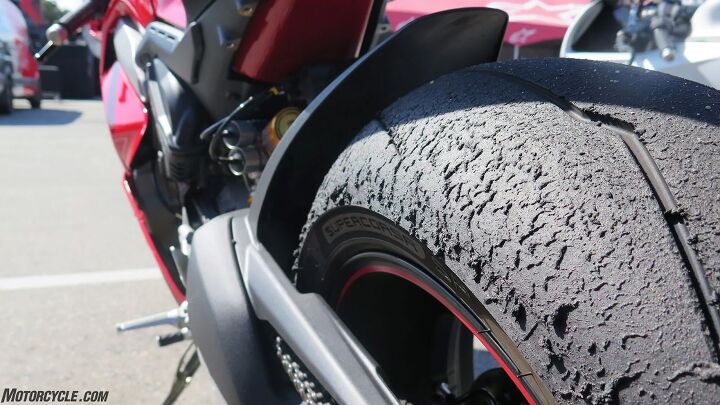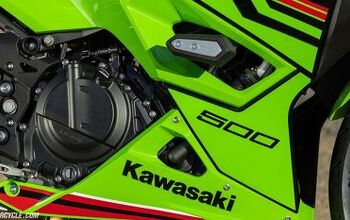How To Know When It's Time To Change Your Motorcycle Tires
The when, where, how, and why of replacing your motorcycle tires
Tires are black, round, and sticky: That's all we need to know about them, right? Well, not quite. Understanding when it's time to change your motorcycle tires is an essential part of rider safety and maintenance that every rider needs to have a firm grasp of, but it isn't always as straightforward as it seems. Various factors can influence why and when you might need to install fresh rubber, ranging from wear, age, or physical damage, and being able to diagnose any potential issues before they become a problem is crucial knowledge. In this article, we'll review the top ways to know when to change your motorcycle tires.
Promoted Product: Shinko SR 999 Long Haul Tire
The Shinko SR 999 Long Haul Tire designed its cruiser tire for high-mileage riding. Shinko has reformulated its rubber compounds to ensure high mileage and confidence-inspiring grip when leaned over. The tread pattern is engineered to provide excellent wet traction without compromising dry-grip performance. In addition, a reinforced carcass results in a planted feel, which is especially important on heavyweight cruiser or bagger motorcycles.
Ensure the Shinko SR 999 Long Haul Tire fits your ride with the Dennis Kirk My Garage Tool.
Check Your Tread Depth
Tires are what we call a "consumable product," which simply means that they wear out. If everything goes according to plan, your bike's tires will gradually wear out over time and allow you to enjoy potentially thousands of trouble-free miles, depending on the type of tire you're using.
Checking your tread depth is easy and doesn't require any specialized tools since all DOT-approved street-legal tires feature "tread wear indicators," often called "wear bars," strategically located between the tire treads to help owners gauge tread depth. If you're struggling to find where these might be, look at the tire's sidewall or sidewall and locate the "TWI" lettering, then search the tread grooving in that area.
The tread wear indicators or wear bars are equivalent to the legal tread limit, which is 1/32nd or 2/32nds of an inch, depending on the state. If the tread has worn to meet those indicators, then that rubber is past its prime, and it's time to replace it. Most of us won't have a ruler handy, but we can reference a penny in a pinch by using Abraham Lincoln's head as a gauge. If Old Abe's head is showing, your tread is worn past the legal limit, which can compromise its ability to grip properly or deliver the performance you've paid for, especially in wet conditions.
Dill Air Controls Tread Depth Tire Gauge
Never Forget Your Tire's Birthday
Every manufacturer has a recommended serviceable lifespan for its tires, which varies considerably. The consensus from major manufacturers is that if maintained and stored correctly, a set of tires has a maximum service life of 5-10 years, depending on the manufacturer issuing recommendations. There is a good reason for these guidelines: tires harden as they age, negatively affecting grip.
When we say "stored correctly," we mean that the tires are stored indoors, protected from harmful UV rays, and in a relatively temperate climate. Should that be the case for your aging rubber, they'll be in good shape. However, we all know that anything subjected to the elements will age faster, especially in hot climates, drying out rubber much quicker.
While no one buying a new bike will be concerned with the age of their tires, there is a quick way to check your tire's manufacturing date by referencing its four-digit code molded into the sidewall. The code is easy to decipher since the first two digits represent the week, and the last two digits represent the year. Let's say your tire's manufacturing code says "1023," which means it was manufactured in the 10th week of 2023.
Wear Pattern 101
So, you've checked out your tread wear indicators, and only certain areas are worn – Whew! You're in the clear! Eh, not so fast, buster! All tires have a profile that engineers carefully design to encourage specific handling attributes from a set of tires. For example, sport tires typically have steeper profiles to initiate quicker turn-in rates, while cruiser tires are often much flatter to focus on stability. Compromising those profiles with inconsistent wear will ultimately compromise the desired handling and ride quality.
Why does this matter? Sometimes, we can face situations where the tire has worn down to the tread wear indicators in one area but not another. That seems confusing, but that's because your tire is wearing unevenly. Again, once you've hit the wear bars, there isn't much rubber left before you'll be wearing down to the steel chords and risk a catastrophic failure.
One of the most common types of uneven wear is called "squaring off," where the center of the tire is noticeably flatter than the shoulder. Riders doing many straight-line highway miles often experience this, simply because they rarely lean their motorcycles. Aside from the rubber being worn out in that area, it will cause sluggish handling.
Another common wear pattern to look out for is "scalloping" or "cupping," which can point to mechanical issues with your suspension or incorrect suspension settings. Scalloping or cupping typically manifests on a tire's shoulder and resembles what it sounds like. The tire wears with what can be described as "scalloped" or "cupped" areas throughout the entire circumference. If this sort of wear pattern is bad enough, it will be felt when riding and easily spotted visually, as the tire will have consistent high and low spots, almost appearing wavy. Typically, this wear pattern happens to the front tire, though the rear can also show these symptoms.
When you do a pre-ride inspection check, and if any of these signs are evident, it's time to order new tires.
Inspect For Damage
Tires are incredibly durable, standing up to dramatic temperature changes, heat cycles, shoddy asphalt — the list is virtually endless. Despite their inherent robustness, they are made of malleable rubber, which makes them susceptible to punctures, gouges, cuts, or bulging that can cause catastrophic blowouts.
Cracking can also occur in tires as they age, commonly known as "dry rot." This sort of thing only occurs over long periods. However, we've already established that storing tires out in the open will dramatically accelerate the process and cause the rubber to lose its elasticity, eventually cracking.
Excessive wear that exposes the tire's carcass shouldn't be ignored. Have you ever heard of a rider wearing their tires out to the cords? They're talking about the physical steel cords beneath the tire's rubber. If that happens, the tire has worn through its rubber and should be replaced immediately. At that point, riding on it in any capacity is no longer safe.
In fact, our very own MOron Troy Siahaan did just that with a set of sportbike tires in a thorough torture test performed in the name of science! Smartly, he concluded the test at that exact moment. Generally, you don't want to take things that far, as the grip and handling characteristics will considerably diminish.
Wrap Up
There you have it, folks. Knowing when to change your motorcycle tires isn't as complicated as it might seem. There are basic rules to follow, and ensuring you're familiar with them is critical to rider safety. Have any questions? Drop them in the comments section.
We are committed to finding, researching, and recommending the best products. We earn commissions from purchases you make using the retail links in our product reviews. Learn more about how this works.
Become a Motorcycle.com insider. Get the latest motorcycle news first by subscribing to our newsletter here.
More by Edward Narraca

































Comments
Join the conversation